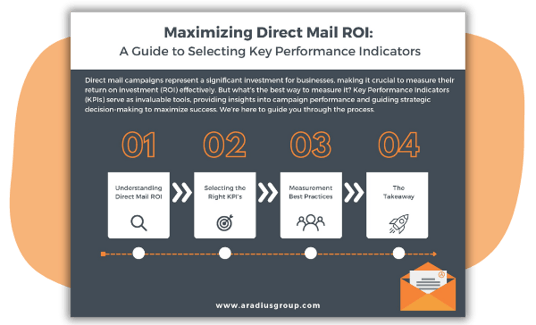A Guide to Direct Mail Data: Doing More with Direct Mail (Part 1)
You’re probably wondering what data means when it comes to direct mail. In short, it’s customer data that’s collected in different ways. It might include a customer’s age, gender, demographic, and address.
There isn’t one right way to collect data, but the way you collect it and use it can be the difference between a successful campaign and one that feels like it’s missing the mark. There’s a lot to break down when it comes to direct mail data and collecting it, so we’re here to help!
Let’s discuss how to collect data, ensure privacy, and create unique personalized mailings for your customers.
Data Collection Techniques
Gathering data for direct mail campaigns involves collecting relevant information about your target audience to personalize and tailor your messages effectively. Let’s break down a few ways to gather data for direct mail:
Customer surveys
This may not be the most popular way to gather data, but you can send out surveys to your existing customers to gather information about their preferences, interests, and buying behaviors. Include questions that help you understand their needs and expectations. To encourage responses, offer incentives, such as discounts or exclusive access.
Purchase history
Analyze your customers’ purchase history to understand their preferences, buying patterns, and product interests. This data can help you tailor direct mail campaigns with personalized product recommendations, exclusive offers, or related items.
Social media insights
Leverage data from social media platforms to understand your audience's interests, engagement patterns, and demographics. Social media analytics can provide valuable insights into the types of content that resonate with your audience, helping you tailor your direct mail messaging.

CRM systems
Utilize Customer Relationship Management (CRM) systems to centralize and manage customer data. CRM systems can store valuable information about customer interactions, preferences, and history, making it easier to personalize direct mail campaigns.
Website analytics
Use website analytics tools to track online user behavior. Understand which pages customers visit, how long they stay, and what products or content they engage with. This information can guide the content and offers you include in your direct mail campaigns.
Buying lists from credible sources
A final option is buying your mailing lists. This includes acquiring a compilation of contact information such as names, addresses, and occasionally additional details of individuals or businesses who meet specific criteria. It’s important to approach the process correctly, ensuring data quality, compliance with regulations, and alignment with the overall marketing strategy. At Aradius Group we’re ready to help you create mailing lists the right way. If you’re interested in building one, reach out!
Remember to prioritize transparency and obtain consent when collecting customer data to comply with privacy regulations. Building a robust and ethical data collection strategy ensures that your direct mail campaigns are not only personalized but also respectful of customer privacy.
The Power of Data in Direct Mail
You’ve gathered the data and now you need to figure out the best ways to use it in your campaign. The data collected is important because it will help create the mailing list you’ll be using to target your potential customers. It provides insight into the preferences, interests, and characteristics of the target audience.
Analyzing demographic data helps creators understand the diversity within their audience and allows for the creation of messages that resonate with a specific group. For example, the messaging for teenagers may vary from content that is targeting retirees.
Another way data helps with direct mail is audience segmentation. This just allows marketers to group recipients based on shared characteristics such as demographics, location, or purchasing behavior. Each group can receive content that specifically appeals to their interests or needs. For example, a clothing store might send different promotions based on age or previous purchase history.
Need help figuring out audience segmentation? Creating buyer personas is the easiest way! We’ve written something up a piece called How to Create Buyer Personas to help get you started.
Geographic targeting allows marketers to customize content based on the recipient’s location, incorporating localized offers, events, and or store information. This adds relevance to the direct mail piece and increases the likelihood of conversion. Who isn’t going to visit a store if they’re offered a 50% off coupon?

Data also allows you to step up your personalization and Variable Data Printing (VDP) on mail pieces. This can be done in a simple way such as using a customer’s name, individual offers, or product recommendations. Personalized content enhances engagement and creates a more meaningful connection with the recipient.
By combining customer data with personalization, you can create direct mail campaigns that are not only more engaging but also more likely to generate positive responses from your audience. Personalized direct mail has the potential to stand out and make a lasting impression, leading to increased customer loyalty and conversions.
Data-Driven ROI and Measurement
Tracking the success of a direct mail campaign involves using data to measure key performance indicators (KPIs) and evaluate the campaign's effectiveness. Here are steps to help you use data to track the success of your direct mail campaign:
Define clear objectives
Clearly define your campaign objectives before launching. Whether it's driving sales, increasing website visits, or building brand awareness, having specific goals will guide your data-tracking efforts.
If you need help figuring out campaign objectives, we've got you covered! We've created a guide filled with tips on understanding ROI, selecting the right Key Performance Indicators for your business, and more. Download your free copy now!

Implement tracking mechanisms
Use unique tracking mechanisms such as personalized URLs (PURLs), QR codes, or specific promo codes for each campaign. These elements allow you to attribute responses or actions directly to your direct mail efforts.
Track website analytics
If your direct mail campaign includes a call-to-action directing recipients to a website, use web analytics tools to track the increase in website traffic, page views, and conversions during and after the campaign period.

Track conversion rates
Measure the conversion rates associated with the campaign, whether it's online purchases, sign-ups, or other desired actions. Calculate the percentage of recipients who took the desired action in response to the direct mail piece.
Set benchmarks for future campaigns
Use the data collected to establish benchmarks for future campaigns. Understanding what worked well and what could be improved will inform your strategy for subsequent direct mail initiatives.
By leveraging these data-driven tracking methods, you can assess the success of your direct mail campaign, identify areas for improvement, and optimize future efforts to achieve better results.
The takeaway
Using direct mail is still one of the most useful marketing tactics today. Leveraging data in your direct mail campaign is a powerful way to deliver personalized and targeted messages. The use of data not only enhances the effectiveness of direct mail campaigns but also allows for precise audience segmentation, personalized communication, and continuous optimization through feedback and analytics.
Investing in data for your campaigns is something you should be doing to make sure you’re putting your best foot forward and standing out against your competitors. Successful direct mail campaigns, informed by data-driven insights, contribute to improved customer relationships, increased brand loyalty, and ultimately, positive returns on investment. Whether you want to start a direct mail campaign, add in data, or both, Aradius Group can help. Reach out when you're ready to get started!


